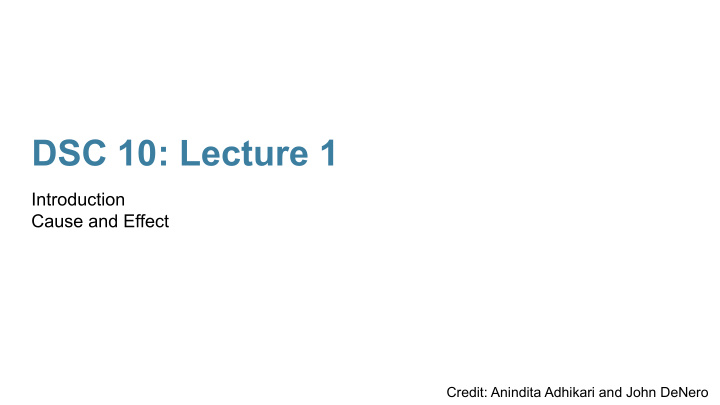



DSC 10: Lecture 1 Introduction Cause and Effect Credit: Anindita Adhikari and John DeNero
Welcome to DSC 10 ● A crash course in data science. ● A course developed by UC Berkeley faculty and students and adapted by UCSD.
Welcome to DSC 10 ● A guided tour of data science. ● Learn just enough programming, statistics to do data science. ● Statistics done without (much) math. Instead: simulation.
Programming experience Do you have any programming experience? A. Yes, I’m a pro (Java, Python etc). Or at least I think I am :) B. I have some experience C. I know a few basic concepts D. No experience whatsoever! Yay! E. Why do you ask? Is it a programming class?
Data Science
What is Data Science? Drawing useful conclusions from data in a principled way. ● Exploration Identifying patterns in information o Uses visualizations o ● Prediction Making informed guesses o Uses machine learning and optimization o ● Inference Quantifying whether those patterns are reliable o Uses randomization o
Literature (Demo)
Literature In chapter 27, Jo moves to New York alone. Her relationship with which sister suffers the most from this faraway move? A. Amy B. Beth C. Meg
Literature Laurie is a man who marries one of the sisters at the end. Which one? A. Amy B. Beth C. Jo D. Meg
Course Page: www.dsc10.com
Lecture 01 : Association and Causality
Really? npr.org (report on a study in heart.bmj.com)
Definitions ● individuals , study subjects, participants, units o European adults ● treatment o chocolate consumption ● outcome o heart disease
The first question Is there any relation between chocolate consumption and heart disease? ● Association: any relation ● Not necessarily causal! (shark bites and ice cream)
Some Data “Among those in the top tier of chocolate consumption, 12 percent developed or died of cardiovascular disease during the study, compared to 17.4 percent of those who didn’t eat chocolate.” - Howard LeWine of Harvard Health Blog, reported by npr.org Is there an association (any relation) between chocolate consumption and heart disease? A. Yes, I think so B. No, I don’t think so C. Maybe, I can’t tell
London in the 1800s
Miasmas, miasmatism, miasmatists ● Bad smells given off by waste and rotting matter ● Believed to be the main source of disease ● Suggested remedies: o “fly to clene air” o “a pocket full o’posies” o “fire off barrels of gunpowder” ● Staunch believers: o Florence Nightingale o Edwin Chadwick, Commissioner of the General Board of Health
John Snow, 1813-1858
Comparison ● treatment group ● control group o does not receive the treatment Which houses were part of the treatment group? A. All houses in the region of overlap B. Houses served by S&V (dirty water) in the region of overlap C. Houses served by Lambeth (clean water) in the region of overlap
Snow’s “Grand Experiment” “… there is no difference whatever in the houses or the people receiving the supply of the two Water Companies, or in any of the physical conditions with which they are surrounded …” ● The two groups were similar except for the treatment .
Snow’s table Deaths per 10,000 Supply Area Number of houses Cholera deaths houses 40,046 1,263 315 S&V (dirty water) 26,107 98 37 Lambeth (clean water) 256,423 1,422 59 Rest of London Does dirty water cause cholera? A. Yes, I think so B. No, I don’t think so C. Maybe, I can’t tell
Key to establishing causality If the treatment and control groups are similar apart from the treatment, then differences between the outcomes in the two groups can be ascribed to the treatment.
Trouble If the treatment and control groups have systematic differences other than the treatment, then it might be difficult to identify causality. Such differences are often present in observational studies. When they lead researchers astray, they are called confounding factors.
Randomize! ● If you assign individuals to treatment and control at random, then the two groups are likely to be similar apart from the treatment. ● You can account – mathematically – for variability in the assignment. ● Randomized Controlled Experiment
Randomized Controlled Experiments ● Assign individuals to treatment and control at random Which of these questions cannot be answered by running a randomized controlled experiment? A. Does daily meditation reduce anxiety? B. Does playing video games increase aggressive behavior? C. Does smoking cigarettes cause weight loss? D. Does early exposure to classical music cause higher IQ? E. All the above can be answered
Careful ... Regardless of what the dictionary says, in probability theory Random ≠ Haphazard
Recommend
More recommend